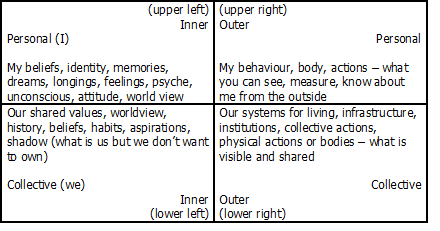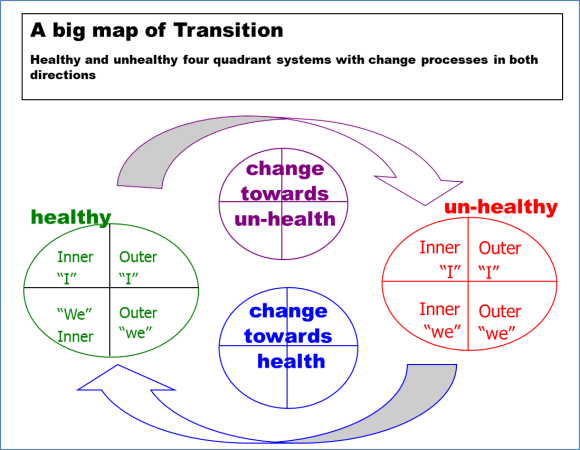This is not the truth.
I like to start with this statement when I’m going to introduce a model. A model is just a model – a map of a territory, not the landscape. If it helps us to understand the landscape better then it’s a helpful model.
Overview
This model helps us think about the balance of healthy and unhealthy elements in a system, and the processes that take us towards or away from health. The “system” could be a person, a project, a society, even an action.
The four quadrant model (from Ken Wilber and others) is helpful to ensure that we include both inner and outer aspects of culture, and that we look across scale from individual to global and beyond.
Determining what healthy culture or not is already a big question. And culture is never static – there is always change happening, some that takes us in a positive direction, some in a negative direction.
Insights that come from this model
- Defining and agreeing what health and unhealth are is the first step to creating healthy culture. There are very different views on this – the Relating or Polarising Archetypes model helps us to see why this is, why there is a “culture war” going on.
- Feedback is crucial to health functioning. Without it we are unable to have any say in where we are going. Creating human systems without feedback is one of the most common and unhelpful things we do. Feedback loops have several stages:
- Stop
- Perceive symptoms
- Make meaning
- Propose remedies for negative symptoms
- Implement remedy/s
- Check whether they have worked
- Repeat
- Over time the change processes will determine the state of the system, not the starting point. A healthy group with a depleting culture will end in burnout; a tired group with a nourishing culture will grow in energy.
Detailed Description of the Model
Four quadrants: seeing a whole world
The first part of this map borrows the idea of thinking about reality from the perspective of inner as well as outer, and across levels of scale.
Inner (the left side) includes everything that has to do with consciousness, that cannot be seen and doesn’t have a physical form. Such as thoughts, feelings, memories, longings, identity, beliefs, values, aspirations and dreams. It also includes what’s unconscious – trauma, parts that are split off or disowned, memories, thoughts or feelings that we can’t access at will.
The Outer part of the map (right side) includes everything physical, visible, measurable – for humans our bodies, health, activities, lifestyle and actions. It also includes the material world around us – the environment, the physical universe.
The scale is divided into two distinguishing individual and collective, “I” and “We”. Looking at human culture, I is one person (upper part), and We (lower part) can be two people, a group, organisation, family, society, the global population. “We” can extend to include ancestors, descendants, other life forms, the rest of the world, the universe and so on.
Here’s the four quadrant model as a table:

You can find a longer explanation of the four quadrant model, and why it’s useful, here.
…more to come
Working with a four quadrant model helps us to see that “culture” has different aspects.
